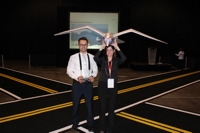
Festo SmartBird takes flight at CMTS: Canadian debut
October 2, 2013
By
Mary Del
 Manufacturing AUTOMATION editor Mary Del Ciancio holding Festo’s SmartBird at its Canadian debut.
Manufacturing AUTOMATION editor Mary Del Ciancio holding Festo’s SmartBird at its Canadian debut. Festo’s bionic flight model, the SmartBird, took to the air for the first time in Canada at the Canadian Manufacturing Technology Show (CMTS) this week, and Manufacturing AUTOMATION was there.
The German manufacturer of pneumatic and electric automation technology invited press to see the SmartBird take flight at the International Centre in Mississauga, demonstrating how nature provides new inspiration for advanced automation technology.
With its SmartBird, Festo hopes to help shape the production and working environments of the future by offering its customers innovative solutions for the production systems of tomorrow and beyond.
The technology was developed by the company’s Bionic Learning Network. Established in 2006, the network links Festo to well-known universities, institutes and development companies. Its objective is to transfer biological principles to industrial automation technology and to provide innovative solutions for industrial applications through bionics. The group is comprised of about 200 employees, and to date has more than 40 projects under its belt — primarily animals that they’ve designed to learn from — including a bionic handling assistant (based on an elephant trunk), which is now used “in the real world” to pick produce, sort mushrooms and sort eggs.
“We’re hoping to use these projects to inspire young people, to get the young minds thinking about how we can take automation to the next level,” said Linda Menheere, product manager with Festo, during the demonstration.
That next level is the SmartBird — an ultra-light (450 grams) but powerful flight model with excellent aerodynamic qualities and extreme agility. This bionic technology platform, which was inspired by the herring gull, can take off, fly and land autonomously — with no additional drive mechanism. Its wings not only flap up and down, but, like it’s natural model, they also twist at specific angles. This is made possible by an active articulated torsional drive, which, in conjunction with a complex closed-loop control system, makes for unprecedented efficiency in flight operation. This functional integration of coupled drives has provided Festo with important ideas and insights for efficiency in the use of resources and energy consumption, which it can apply to the development and optimization of hybrid drive technology. The minimal use of materials and extremely lightweight construction of the SmartBird lead the way towards resource- and energy-efficient designs.
The development of the SmartBird started in 2009, and it took the company two years to perfect it. CMTS marks the Canadian debut of the bird, and it will be on display at the show until October 3.